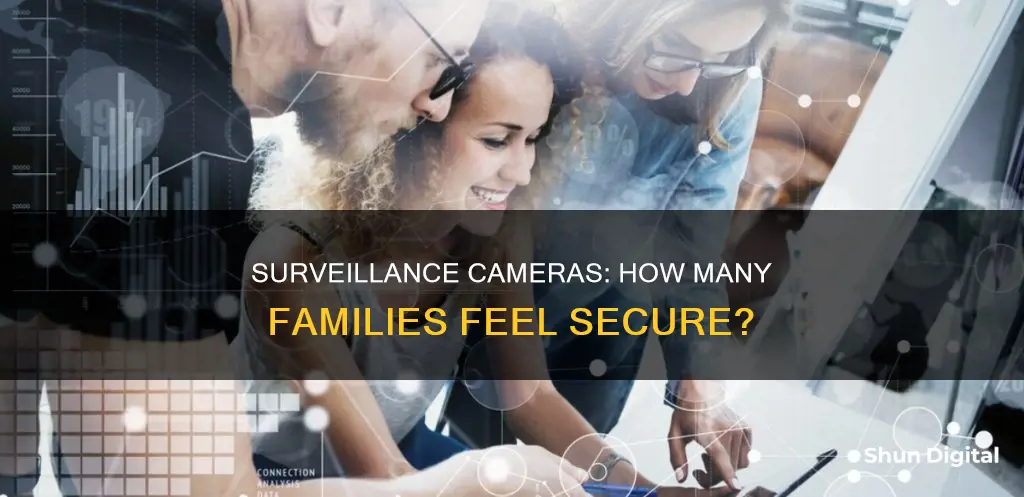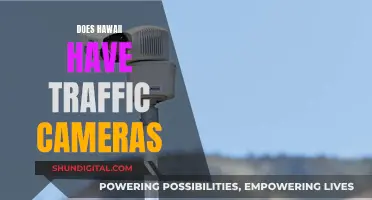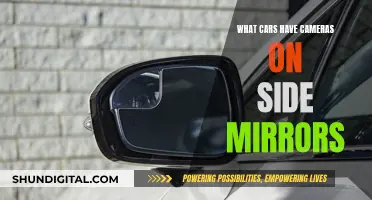
The adoption of home surveillance cameras has been steadily increasing, with a growing awareness of home security and advancements in technology. While the percentage of households with surveillance cameras varies depending on region and demographic factors, it is clear that their use is becoming more common. In the United States, surveys indicate that around 45% to 47% of households have some form of surveillance system installed, with Millennials being the generation most likely to adopt this technology.
What You'll Learn
- Millennials are the generation most likely to have security cameras installed in their homes
- Home surveillance is increasingly being used to monitor children, spouses and neighbours
- % of households had some form of surveillance cameras installed in 2020
- % of American households reported having some form of home security system in 2019
- % of people without home surveillance tech say it's too expensive

Millennials are the generation most likely to have security cameras installed in their homes
The adoption of home surveillance cameras has been on a steady rise in recent years, with the percentage of families that have them varying depending on region and demographic factors. While it is challenging to provide an exact global figure, a 2020 survey conducted in the United States estimated that around 47% of households had some form of surveillance cameras installed.
Millennials, individuals currently aged between 27 and 42, are the generation most likely to have security cameras installed in their homes. According to a LendingTree survey of over 2,000 consumers, 72% of millennial homeowners have some type of surveillance technology in or around their homes, compared to 69% of Gen Z homeowners, 47% of Gen X homeowners, and 30% of baby boomer homeowners. This trend may be attributed to millennials growing up in a more camera-centric world, where surveillance cameras are seen as an extension of the technology they carry, such as smartphones and smartwatches.
The use of home surveillance cameras among millennials is driven by various factors. One key reason is crime deterrence, with 63% of millennial homeowners believing that their cameras have prevented potential criminal activity on their property. Additionally, the COVID-19 pandemic has played a role, as more people spent time at home and became more conscious of their security needs. The rise in online shopping and package thefts has also contributed to the increased demand for surveillance cameras among millennials.
Furthermore, millennials are using surveillance technology not only for security but also for monitoring their loved ones. Among millennial respondents with surveillance technology, 46% have used it to keep an eye on their young children, and 25% have used it to monitor their spouse. This reflects a growing trend of utilizing surveillance cameras for versatile purposes beyond just crime prevention.
While the adoption of home surveillance cameras offers benefits such as increased security and peace of mind, it is important to consider potential drawbacks. One concern is the invasion of privacy, as the presence of cameras in shared living spaces may raise privacy issues among family members or roommates. Additionally, the cost of purchasing and installing surveillance equipment can be a significant barrier, with 38% of consumers without home surveillance tech citing affordability as the main reason for not adopting it.
In conclusion, millennials are the generation most likely to have security cameras installed in their homes, driven by factors such as crime deterrence, technological advancements, and the desire to monitor loved ones. As technology continues to evolve and become more accessible, it is likely that the adoption of home surveillance cameras among millennials and other generations will continue to grow.
Lightroom Presets: Importing into Camera Raw
You may want to see also

Home surveillance is increasingly being used to monitor children, spouses and neighbours
The adoption of home surveillance cameras has been on the rise in recent years, with an increasing number of families installing them for added security and peace of mind. While the percentage of families that have surveillance cameras at home varies depending on region and demographic factors, it is estimated that around 47% of American households have some form of surveillance system in place. This trend is driven by factors such as advancements in technology, rising crime rates, concerns about personal safety, and the impact of the COVID-19 pandemic.
Home surveillance is increasingly being used to monitor children, spouses, and neighbours. For parents, the ability to keep an eye on their children, especially when they are away, can provide a sense of security and control. This is facilitated by the growing number of surveillance tools available, such as video baby monitors, GPS-tracking software, and "smart" speakers. However, it is important to note that the use of surveillance to monitor children is not without its ethical considerations. In the United States, the Children's Homes (England) Regulations (2015) outline that surveillance of children in care homes is only permissible when necessary for safeguarding and promoting the welfare of the child and that children should be informed about any monitoring systems and their purpose.
Spouses and partners also find themselves under the watchful eye of surveillance cameras, with some individuals engaging in digital monitoring of their significant others' locations, social media accounts, and online activities. While this may be done with the intention of ensuring safety, it can cross the line into unhealthy vigilance and stalking.
The use of home security cameras has also had an impact on relationships between neighbours. On the one hand, it provides a sense of community and belonging, with neighbours working together to ensure the safety of their neighbourhood. On the other hand, it can drive neighbours apart, as people become more comfortable with constant surveillance and outsource their trust to technology rather than building personal relationships. Additionally, the normalization of surveillance can lead to ethical distancing, where individuals view their neighbours' activities through camera feeds rather than face-to-face interactions, degrading physical interactions and a sense of obligation to others.
Mastering Camera Focus Points for Sharp Photography
You may want to see also

47% of households had some form of surveillance cameras installed in 2020
The adoption of home surveillance cameras has been on an upward trajectory in recent years, with an estimated 47% of American households having some form of surveillance system installed as of 2020. This trend is influenced by various factors, including technological advancements, rising security concerns, and the impact of the COVID-19 pandemic.
The increasing popularity of home surveillance cameras can be attributed to several reasons. Firstly, advancements in technology have made these systems more accessible and user-friendly, allowing families to fortify their homes against potential dangers. The integration of smart home technologies, such as video doorbells and wireless cameras, has played a significant role in this shift. Moreover, the rise in remote work and online shopping during the pandemic has heightened awareness of home security, with package theft being a growing concern.
It is worth noting that the adoption rate of home surveillance cameras varies across different regions and demographics. Urban areas and higher-income households tend to have higher installation rates due to a perceived higher risk of crime. On the other hand, rural areas and lower-income households may have lower adoption rates because of cost constraints or a lower perceived need for surveillance.
The demand for home surveillance cameras is expected to continue growing. The global home surveillance camera market is projected to expand significantly, driven by increasing safety concerns, rising urbanization, and the growing adoption of smart home technologies. Additionally, the impact of the COVID-19 pandemic has likely contributed to a sustained interest in home security solutions.
While the exact percentage of families with surveillance cameras may vary across different sources and regions, it is clear that their presence in households is becoming increasingly common. As technology continues to advance and become more affordable, it is likely that the percentage of families investing in surveillance cameras for their homes will also increase.
Troubleshooting Camera Focus Issues on LG Devices
You may want to see also

45% of American households reported having some form of home security system in 2019
The adoption of home surveillance cameras among families has been steadily increasing, and it is challenging to provide an exact percentage of those who have them installed. A 2020 survey estimated that around 47% of US households had some form of surveillance camera installed. This percentage varies across different countries and regions due to cultural, economic, and security factors.
In 2019, a study by the Electronic Security Association (ESA) found that approximately 45% of American households reported having some form of home security system, a significant increase from previous years. This indicates a growing trend towards enhanced security measures in American homes. The main reasons for installing surveillance cameras were to deter burglaries and monitor the safety of children and pets.
The COVID-19 pandemic has also played a role in the increased adoption of home surveillance cameras. With more people working remotely and spending more time at home, there is a heightened awareness of home security. Additionally, the rise in online shopping and package thefts has further driven the demand for surveillance cameras.
Urban areas and higher-income households tend to have a higher adoption rate of surveillance cameras due to a perceived higher risk of crime. On the other hand, rural areas and lower-income households may have lower installation rates due to cost constraints or a lower perceived need for surveillance.
The use of home surveillance cameras is expected to continue growing as technology advances and more families recognize the importance of home security. The global home surveillance camera market is projected to expand significantly, driven by increasing safety concerns, urbanization, and the integration of smart home technologies.
It is worth noting that the presence of home security systems can act as a deterrent to potential burglars. According to studies, most burglars opt to avoid homes with visible security measures, and the presence of an alarm system can effectively discourage break-in attempts.
Charging Your Canon Camera Battery: A Step-by-Step Guide
You may want to see also

38% of people without home surveillance tech say it's too expensive
The adoption of home surveillance cameras has been on a steady rise in recent years, with an estimated 47% of American households having some form of surveillance system installed as of 2020. This increase in adoption can be attributed to various factors such as technological advancements, rising security concerns, and the impact of the COVID-19 pandemic. However, it is worth noting that the adoption rate varies depending on location, income level, and personal preferences.
While the demand for home surveillance cameras is high, there are still a significant number of people who have not adopted this technology. According to a survey by LendingTree, 38% of people without home surveillance technology cited its high cost as the main reason for not adopting it. This is especially true for Gen Xers, with 44% of this generation stating that home surveillance technology is too expensive. Millennials followed closely behind at 39%, then Gen Zers at 36%, and baby boomers at 32%.
The high cost of home surveillance technology can be a significant barrier for many, especially when considering the other expenses associated with owning or renting a home. Additionally, some people may have other means of protection, such as alarm systems or dogs, which they believe are sufficient for their security needs.
It is also important to note that the survey found that 14% of respondents who earn $100,000 or more annually are not confident that home surveillance technology can provide effective protection. This is nearly half the percentage of those who earn less than $35,000 and express the same sentiment. This suggests that income may not be the only factor influencing the decision to adopt home surveillance technology, and that other factors, such as personal risk assessment and privacy concerns, may also play a role.
In conclusion, while the adoption of home surveillance cameras is on the rise, cost remains a significant barrier for a substantial number of people. As technology continues to advance and become more accessible, it is likely that the percentage of families with surveillance cameras will continue to grow. However, it is important to address the financial constraints and privacy concerns associated with this technology to make it more accessible and appealing to a wider range of individuals.
Night Owl Camera Batteries: How Long Do They Last?
You may want to see also
Frequently asked questions
The percentage varies depending on the region and demographic factors. While there is no comprehensive global data available, a 2020 survey in the United States estimated that around 47% of households had some form of surveillance cameras installed.
The main reasons for installing surveillance cameras are to deter burglaries, monitor the safety of children and pets, and prevent package theft. With the rise of online shopping, there is an increasing concern about package theft, and surveillance cameras offer a solution to this issue.
According to surveys, a significant majority of people (96%) feel safer when their neighborhood has home security cameras installed. Additionally, 90% of people believe that having security cameras in place helps deter criminal activity.
One concern is the potential for hacking. Almost half of the respondents (49%) in a survey expressed worry about hackers accessing their security cameras and private footage. Another concern is the ethical aspect of using indoor security cameras to monitor domestic workers or teenagers without their knowledge or consent.
Yes, there are generational differences in the adoption of home security systems and smart home security cameras. Millennials are more likely to have security systems (45%) and smart home security cameras (30% more than Baby Boomers) compared to Baby Boomers (12%).







